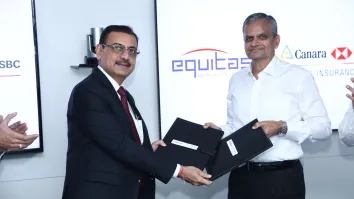A complement, not replacement: Understanding parametric insurance
By Patrick BühlerWith rising disasters and cyber-attacks, parametric insurance offers an alternative to traditional indemnity-based coverage.
From natural disasters to cyber-attacks, organisations worldwide have been wrestling to defend against these complex and unprecedented challenges. Today’s world is filled with uncertainty, thus demanding continuous adaptation and change to survive. Singapore – and more broadly, Southeast Asia – is no exception.
Climate change has brought about extreme weather events, with Singapore experiencing increasing flooding occurrences. Due to rising sea levels and the higher frequency of tropical storms, the government has allocated S$5 billion towards funding aimed at coastal and flood protection measures. The country is also experiencing warmer weather than usual, due to the lingering effects of El Nino.
Extreme shifts in the weather have also been felt across the region. Typhoon Gaemi, which took the lives of at least 14 people when it made landfall in the Philippines, is a prominent example. Southeast Asian countries (Vietnam, Thailand, Indonesia, and the Philippines) are ranked among the highest globally for flood and typhoon risks, and other natural hazards. The financial toll exerted is immense, with 85% of economic losses uninsured from 2014 to 2023 in Asia alone. As such, the impact of climate disasters is growing in severity and is devastating to the lives of populations, crying out a pressing concern.
Aside from climate change, the rise in the frequency of cyber-attacks in our digitised world is also worrying. According to the “State of OT Security” report, over 70% of respondents have faced at least one cyberattack. A recent poll by Globaldata has revealed that cyber risk is now deemed the most significant threat to the insurance industry, surpassing natural catastrophes and political risks.
With many unpredictable events bringing impactful and negative consequences, the insurance market has been the mainstay in providing coverage against these disruptions. Traditional indemnity-based insurance has been well-established in transferring risk and mitigating physical damage. However, with the increasing frequency of climate-related disasters, and evolving digital landscape bringing about potential damage to intangible assets, are conventional insurance policies enough?
This is where parametric insurance steps in.
What is Parametric Insurance?
Parametric insurance is a type of insurance that pays out a predetermined amount based on the occurrence of a specific event. It relies on predefined parameters, such as wind speed, earthquake magnitude, or rainfall levels, to trigger payouts. Therefore, it is based on the magnitude of the event, not the magnitude of the losses.
Traditional insurance follows the latter, where reimbursement is based on the losses incurred. It is best used for protecting owned physical property, due to established risk assessment methodologies, contract terms, and standard coverage options.
Parametric insurance, in contrast, is more cost-effective than traditional insurance plans. This is because traditional insurance needs manual resources to assess a claim and determine the real loss incurred, whereas parametric insurance pays out automatically based on a predefined event as long as the thresholds are met or exceeded.
Key Features of Parametric Insurance
Parametric insurance follows predefined triggers. Predefined triggers utilise parameters – a metric or index relating to the physical characteristics of a natural event. Examples of natural events include weather events, natural disasters, network outages, and logistics and time-sensitive delivery. For example, parametric insurance can cover the magnitude of an earthquake or the wind speed of a hurricane and is measured by a third party that provides unbiased and transparent data.
Since the metrics are based on triggers, parametric insurance follows a more proactive approach, facilitating an efficient and alternative way of providing coverage. The absence of a loss assessment period and the indemnity component in the triggers ensure quick claims processing, a feature that sets parametric insurance apart. This unique aspect enables parametric insurance to cover risks that are difficult to assess or traditionally uninsurable through conventional insurance methods. Thus, parametric insurance eliminates the core nuisance of the insurance industry: lengthy waiting time and uncertainty about whether and when a claim will be paid out. It makes insurance more attractive and transparent.
Debunking Myths about Parametric Insurance
Myth #1: It is more expensive than traditional indemnity insurance
The policy coverage for the two involves very different aspects. The suitability of the insurance highly depends on events that have occurred. One isn’t necessarily better or cheaper than the other and should be seen as the one that can provide the most coverage based on the circumstance. However, it allows insurance to make insurance cheaper based on those who cannot afford traditional insurance, as the sum insured can be determined independently of an actual suffered loss, resulting in a lower premium.
Myth #2: It is complex and difficult to understand
This is not true!
Parametric insurance is the relatively lesser-known type, given that few are familiar with it. However, its perceived complexity shouldn’t be misjudged simply because its mechanism differs from traditional insurance. With parametric insurance’s predefined triggers and pre-agreed payout rates, its solutions are more customer-centric and transparent.
Myth #3: It only applies to Natural Catastrophe (Nat Cat) events
Although Nat Cat events are more prominent triggers, parametric solutions cover beyond those triggers and events. If the index involves a chance or unpredictability, it has the potential to be used as a trigger.
For instance, parametric insurance can help public and corporate entities close their insurance protection gap, especially when disruptions might not induce physical damage. An example can be cyberattacks disrupting business operations, leading to losses in revenue. Since the payout is linked to triggers and not property damages, the policy can still help cover the losses from the interruption.
Like the rest of the world, the Southeast Asia region isn’t free from setbacks and calamities. Fortunately, insurance acts as a shield against potential losses. While parametric insurance is still in its nascency, it has huge potential to address the protection gap, especially in our increasingly digitised world. As data from various sources continues to expand, the potential for parametric products grows, sparking curiosity about their diverse future applications.
Parametric insurance has unique characteristics that differ from its traditional equivalent. It provides coverage and eases the losses caused by different events–some of which traditional insurance cannot fully cover. Living in today’s complex, shifting, and unpredictable world, it is imperative to understand the nuances these two insurance policies bring. Knowing the differences allows us to gain the full benefits of the insurance plans, helping ourselves receive the protection we are entitled to.




















 Advertise
Advertise









